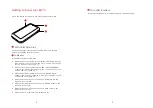
10
operation of this electronic device.
Pacemaker manufacturers recommend that a minimum
separation of 15 cm be maintained between a wireless device
and a pacemaker to avoid potential interference with the
pacemaker. Deactivate your wireless device, if it may have
disturbance to the pacemaker
Deactivate in Explosive Areas
Deactivate your wireless device where the air is potentially explosive.
It is rare, but your PC could generate sparks.
Deactivate in Blasting Areas
Deactivate your wireless device where blasting is in progress.
Remote-controlled radio frequency (RF) devices are often used at
construction sites to set off blasting.
Deactivate in Aircrafts
Deactivate your wireless device before boarding or in any aircraft.
Wireless devices can cause interference in aircrafts.
Deactivate at Hospitals
Obey regulations or rules at hospitals. Deactivate your wireless
device near medical equipment. Wireless devices can cause
interference to cardiac pacemakers, implanted defibrillators or other
medical equipment.
Deactivate near Hearing Devices
Deactivate your wireless device near hearing devices. People with
hearing aids may experience interfering noise near wireless devices.
Recommendations for Children
Do not allow children to play with your wireless device. They could
hurt themselves or others, or could accidentally damage the wireless
device. Your wireless device contains small parts with sharp edges
that may cause an injury or a choking hazard.
11
Deactivate While Driving
Do not use the wireless device while driving.
Immunity to Interference
Your wireless device is immune to interferences caused by audible
signals.
Cleaning and Maintenance
Before you clean or maintain the wireless device, stop all
applications using the wireless device and remove your wireless
device from your PC.
Clean your wireless device with a piece of soft antistatic cloth.
If the wireless device or any of its accessories does not work, turn
to an authorized service center for help.
Environmental Protection
Observe the local regulations regarding the disposal of your
packaging materials, old wireless device and its accessories. Please
promote their recycling.
SIM/USIM Cards
While inserting or removing the SIM card, protect yourself against
electrostatic discharge (ESD). Do not touch the connector of the SIM
card. As a precaution, always make sure that the wireless device is
already in your hand before you insert or remove the SIM card.
Restart on ESDs
Software will attempt to re-initialize a connection once a substantial
electrostatic discharge causes the device to reset. If the software is
not operational after an ESD, restart the software application.
Agency/Regulatory Information
The wireless device is approved for use in many regions of the world.
In these regions, the device meets all radio frequency exposure



























